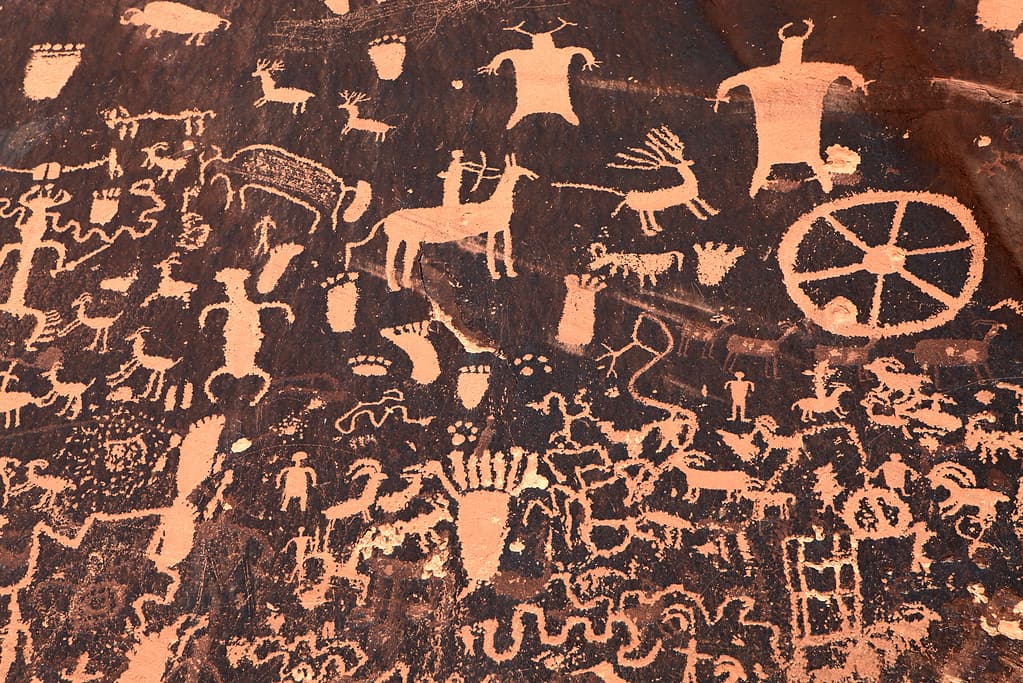In almost every part of the world, people can find tales of elusive creatures that seemingly defy scientific explanations. The term for these legendary beings is cryptid. Lurking at the threshold between myth and reality, they have evaded capture and bewildered skeptics for centuries. Cryptozoology, the study of hidden animals, exists to explore lore and legend to unravel the mysteries behind these cryptic entities. Among the many curious creatures is the chilling legend of the skinwalker. This cryptid has deep roots in Native American culture and is most widely known for its terrifying shape-shifting ability. That said, let’s delve deeper into the realm of the skinwalker to explore this intriguing entity’s origins and behaviors.
Origins of the Skinwalker

UFO and cryptid fans view Skinwalker Ranch in Utah as the world’s most mysterious hot spot for UFOs and “high strangeness” phenomena, including many skinwalker sightings.
©Kresopix/ via Getty Images
To begin, we must first examine the history and origins of the world-famous skinwalker. First, this legend has been passed down across many generations through oral storytelling within many Native American tribes — but most predominately among the Navajo people in the southwestern United States. Because of this, it is very challenging to pinpoint the exact date of the oldest account. Nevertheless, the detailed folklore surrounding skinwalkers has undoubtedly shaped indigenous culture and spiritual traditions for centuries. Over time, the legend grew beyond native stories, gaining wider recognition among the general public. Due to its inexplicable nature, this creature’s popularity exploded! To this day, skinwalkers continue to captivate the interest of paranormal enthusiasts, cryptozoologists, and those simply curious about the unanswered mysteries lurking just beyond our natural world.
Appearance and Behaviors of This Cryptid

Many believe skinwalkers commonly take the form of a coyote.
©hpzima/ via Getty Images
Now that we know their origins let’s get into what skinwalkers really are and why they are so frightening! To start, many Southwestern indigenous tribes associate the skinwalker with dark magic and malevolent actions. They are also linked to vast, isolated landscapes, such as the deserts, mountains, and forests found in that region. In Navajo culture specifically, it is believed that only people who engage in forbidden or taboo practices — such as killing another human or partaking in witchcraft — can acquire the power to become a skinwalker. Because of this, typically, all skinwalkers are shamans or witches.
Characteristics of the Skinwalker
One of the most common telltale signs of a skinwalker is its ability to shape-shift into animals or even people. The most common forms skinwalkers take on are desert animals like wolves, coyotes, and owls. In its natural state, this cryptid appears in its original human form — the only difference being its cold, piercing, unnatural eyes. Some people suggest that their “glowing eyes” are one of the only things they cannot alter! Almost all urban legends of the skinwalker depict the use of their unique shape-shifting to inflict harm, bring illness, or spread fear among singular people or entire tribes.
Skinwalkers are also said to possess an almost intimate knowledge of their victims. In turn, they use this awareness to exploit their victim’s greatest fears and weaknesses. One of the most common ways they lure prey in is through voice mimicking. Additionally, skinwalkers are skilled at fear manipulation. This gives them the power to instill intense fear and unease in those who encounter them. Again, this is yet another hunting tactic skinwalkers use to control and prey on their victims.
Truth Behind the Legends

Tales of skinwalkers date back to ancient native civilizations, particularly those of the Navajo.
©imagixian/ via Getty Images
Numerous accounts and stories exist recounting alleged encounters with the skinwalker cryptid. These tales often involve unexplainable sightings, events, or encounters with mysterious “shape-shifting” entities. Eyewitness reports also put the blame on skinwalkers for the strange behavior of animals and unearthly sounds heard in the dead of night.
Beyond the cultural significance of skinwalkers, tribespeople could have intended this folklore to keep children from misbehaving. Alternatively, these stories could have been a way to preserve traditional knowledge between the southwestern tribes. These urban legends’ popularity, especially in recent years, might have emerged as a way to explain unusual or uncommon events. Misidentification is one of the most significant factors contributing to the abundance of reported skinwalker sightings in recent years, most likely made paranormal by our fear of the unknown. So, even though scientific evidence cannot advocate for the existence of these creatures, they still live on in reality through indigenous heritage, mainstream legends, and fearful encounters in the desolate expanse of night.
The photo featured at the top of this post is © Sara Edwards/Shutterstock.com
Thank you for reading! Have some feedback for us? Contact the AZ Animals editorial team.






